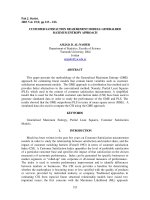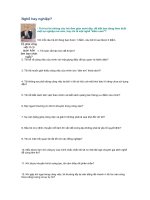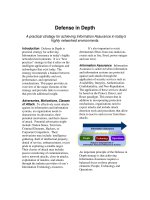Tài liệu Customer satisfaction measurement docx
Bạn đang xem bản rút gọn của tài liệu. Xem và tải ngay bản đầy đủ của tài liệu tại đây (59.24 KB, 14 trang )
1
baldrigeplus
adding value to excellence
in your organisation
Exhibit
The mission of baldrigeplus.com is to add value to your investments in excellence
by publishing and supporting a set of analytical tools that make the Baldrige
system accessible, understandable and applicable to your organisation
COPYRIGHT
1999 Macpherson Publishing, PO Box 270, Alexandra, New Zealand
Telephone +64 03 448 9524, Fax +64 03 448 7986, Email
This document is not to be reproduced without the prior consent of the copyright holder.
MISSION
Customer satisfaction
measurement
2
Customer satisfaction measurement
A primer
Introduction
Baldrigeplus.com exhibits are single-topic publications designed to illustrate and
explain key Baldrige concepts. Used with the associated workshops, worksheets,
case studies and Baldrige-sourced material, exhibits are intended to add value to your
performance excellence activities.
Return to the Welcome page for links to the other resources.
Do you know if your customers are satisfied?
Answer this questionnaire to see if there is anything you could be doing to know your
customers better.
1. Does your small business have a strong customer-retention program in place?
2. Do you receive feedback from customers on a regular basis?
3. Has your small business made changes or implemented ideas at the request of
customers?
4. Do you call on customers just to see how your company’s products and
services are working?
5. Do you have an idea about what products or services your customers plan to
purchase in the next year?
6. Do you send out surveys on a regular basis to solicit input from your
customers?
7. Are your customers happy and can you quantify their satisfaction level?
8. Do you know who your best and most loyal customers are?
Source - smallbiz.symantec.com
Your customers have the answers
Knowing your customers is key to growing your business. Customer satisfaction is
essential for long term success. You want your customers to be happy with the
products and services you provide and you want them to stick with you as their needs
grow and change.
Your customers have the answers, but getting them to tell you what’s good about your
business, and where you need improvement is the challenge. Surveys are an
excellent way to find out how your customers feel about a new product, service,
location, store policy or virtually anything that's important to your business. A survey
will tell you what your customers expect of you and your company, and clarify how
well you are performing in their eyes.
A customer satisfaction survey is one way to gather vital information. There are a
number of ways to get copies of the survey to your customers. Copies can be included
with orders, mailed directly to customers or done via a phone survey. Not all your
customers will return their surveys, but those who do will make it worth your while.
3
If executed properly, you can achieve impressive results without spending a lot of
money. Customer service experts estimate it can cost between $3,000 - $5,000 to
sample a representative segment of your customers.
Better customer surveys
Surveys are an excellent way to find out what your customers think about your
products and/or services, telling you what your customers expect and what they are
and aren't getting. But the secret to any good survey is the questions! If you don't ask
the right questions, you are just wasting your time and that of your customers.
Here are ten tips for better customer questionnaires.
1. Start with a clear objective
What are you trying to learn? Understanding why you are surveying your
customers is an essential first step for better results. A strong survey has a clear
goal or focus (to find out how customers feel about a new location or store
layout; get response to a new product or service; learn why once loyal
customers are now shopping elsewhere). Be clear about why you're surveying
your customers, and you will get results that will help you make your business
more effective.
2. Be honest
Tell your customers why you are asking them questions and why their
feedback is important. Don’t dress-up your survey as something else.
3. Keep your survey short and simple
You are asking customers for their valuable time so don't waste it. Keep
questions direct, simple and brief. Long, wordy multi-part questions should be
avoided. The longer the survey, the less likely you are to get responses. Keep
the questions short. Scaled questions (strongly agree, agree, slightly agree,
don't care) or yes/no questions are the easiest to answer. An example of a
good question: How well do you feel your accountant meets your tax needs?
Ideally, your survey should consist of 10-12 such questions, on one page.
Consider using a response scale (called a Lickert scale) with an even number
of options, usually four or six, to force a positive or negative response:
m Strongly agree m Agree m Disagree m Strongly disagree
That way, your customers can’t sit on the fence by marking a ‘neither agree
nor disagree’ option.
4. Ask questions that are important to your customers, Make sure the questions
you ask directly affect the customer. If you ask them questions they don't care
about you are less likely to get useful information. Customers aren't concerned
with issues that do not pertain to them (hiring, promotion or store policies,
outreach programs). Make sure that each question is important to your
customers' needs, not your internal management, and remember that
successful surveys are fun to fill out. Don't waste your customers' time.
5. Give them an incentive for responding
It might be as simple as a sentence at the top of the survey indicating that you
are using the input to evaluate current policies/products and create new ones
− customers like to feel like they can have an impact on your company. Ron
Zemke, author of Coaching Knock Your Socks Off Service suggests including
discount coupons for certain products or services with the survey, particularly
if you're using your survey to prospect for new customers.
4
6. Encourage opinions
If you are seeking actionable data, and that’s surely the key purpose of your
survey, leave space at the end for comments – or better still, add a comments
line after every question, encouraging respondents to express their opinions.
Many service businesses, for example, have been successful with questions
such as, "If this were your business, what would you do differently?" If
respondents feel strongly about the issue, pro or con, there's an excellent
chance they'll answer it. Look at IBM’s customer survey approach (see the
exhibit Customer relationship management at IBM Rochester). If customers
have the option of marking your products or service unsatisfactory, or worse,
always ask ‘what could we do to improve your satisfaction …’
7. Use a confidential self-mailer to generate higher response rates
The easier it is for people to respond, the higher the response rate will be. Self-
mailers are highly recommended because they require less paper and
postage. Next best is including an addressed pre-stamped envelope. ( It's
presumptuous to expect respondents to use their own postage.) Also, stressing
the survey's confidentiality increases your chances of getting honest answers.
8. Test your survey before mailing it
Andy Mosko, managing principal of Organizational Research Forum, Inc.,
Vernon Hills, IL, a company that specializes in designing customer surveys,
advises testing a survey before mailing it. Try it out on a few good customers,
he says. You'll be pleasantly surprised to discover it can be improved.
9. Focus your surveys on your most important customers
These are the people whose opinions you value most. If the lion's share of
your business comes from only 8 or 10 customers (as may be the case with a
small service business), design your survey with their needs in mind (and take
a look at the Solectron on customer relationship management in the
baldrigeplus.com case study collection and the related exhibits).
10. Preview your survey with postcard arousing curiosity
A brief attention-commanding announcement should be delivered a week
before the survey is officially sent. It's an opportunity to highlight the benefits
(premium, discount or special money-saving coupon) of filling out the survey
and sending it back promptly.
Sources - Symantec’s small business resources,
at smallbiz.symantec.com, americanexpress.com
How Big Is Big Enough?
From an article by Tom McGoldrick, David Hyatt, and Lori Laflin, of American
Demographics/Marketing Tools, a unit of Cowles Business Media
When it comes to sampling, size matters
One of the most common sampling questions is, ‘How many people do I need to
survey to have valid data?’ There's only one answer: ‘It depends,’ … on what you
want to do with the data you collect.
The goal of surveying is to find out how everyone who matters feels about a topic, but
most of the time it's impractical to ask them all, so we ask a small number, a sample,
and use the results to make assumptions about what all of them think. We want to
know how the population feels, but we are only asking a slice of the population.
5
One of the first things to do before deciding on a sample is to think about the
characteristics of the population that will be important to you. This ensures that when
you're drawing your sample, you will represent those groups appropriately. A sample
is only valid to the extent that it mirrors the population of interest.
There are any number of ways to select a sample, most fall into one of two groups:
probability and non-probability.
1. Probability sampling is a type of sampling where every member of the
population has a known (usually random, and equal) probability of being
sampled
2. Non-probability sampling is when certain members of the population are
chosen because of a judgment on the characteristics of the population and the
needs of the survey. Non-probability samples are created because the units
appear representative or because they can be conveniently assembled; hard-
to-find groups, surveys of specific groups, and surveys in pilot work. Non-
probability is not random because not all members have the same chance of
being drawn for the survey. Some have no chance at all.
Types of probability sampling
Simple random sampling where each member of the population has the same chance
of being selected. In order to achieve a true simple random sample, you will need to
develop a list that includes all of the members of the population, then randomly pull
names from the list. The biggest advantage to a simple random sample is that it
provides an unbiased sample fairly easily. The biggest downside is that it may not
capture all elements of the population that are of interest.
Stratified random sampling where the population has been classified into strata, or
subgroups, and then a random sample is pulled from each subgroup. A common
question is, what strata do you use? The answer is to develop strata based on
characteristics that should have an effect on the results, think about what groups you
will want to compare when analyzing the data.
Systematic sampling where names are taken systematically from a population using a
ratio of population to desired sample. For example, if you had a random list of 3,000
customers and wanted to send surveys to 500 of them, you would select every 6
th
person and send them a survey. You need to be sure the population is not ordered to
begin with, or that there is no naturally reoccurring pattern.
Cluster sampling. The final type of probability sampling, cluster sampling, uses
naturally occurring clusters such as business units, schools, hospitals, or city blocks,
randomly selects a subset of them, and then samples everyone in the chosen cluster.
Cluster sampling is traditionally only used in large-scale surveys. It is different from
stratified sampling in that you start with naturally occurring clusters; you don't
develop them.
Types of non-probability sampling
Convenience sampling. A convenience sample is a group of people whom you can
conveniently locate and survey. The sample may not generalize to the target
population.









